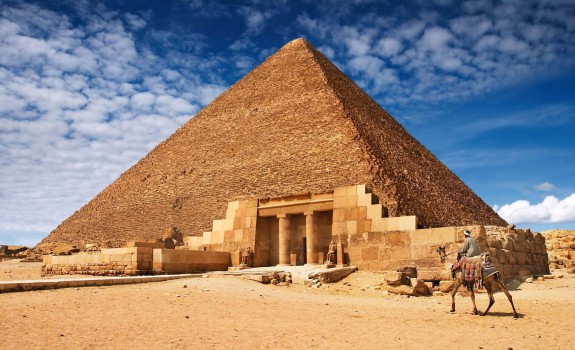Image Source: Internet
http://www.history.com/topics/ancient-history/the-egyptian-pyramids
For more than 2,000 years, Egypt was one of the richest and most civilized lands in the ancient world. Much of what we know about this great civilization has been learned from its art and architecture. In particular, the ruins of tombs and temples have provided a valuable record of Egyptian life.
The Egyptians were extremely religious, and their belief in life after death was an important part of their culture. They believed that, in order for the spirit to live on, the dead person’s body had to be preserved, or mummified, and buried along with supplies of food and drink, tools and utensils, valued possessions—all the things the person had needed or enjoyed on earth. The higher the person’s station in life, the more extensive the preparations for the afterlife. Kings and other wealthy persons had elaborate tombs built. Sculptures and wall paintings in the tombs were also created for use in the next life.
The first great period of Egyptian civilization, called the Old Kingdom (2650-2150 B.C.), began during the rule of King Zoser. The Step Pyramid was designed as a tomb for Zoser and members of his family. It was an unusual pyramid because of its broad terraces, or “steps.” It consisted of seven rectangles, each rectangle smaller than the one beneath it. Within the rock was a well where the king was buried.
The form of the pyramid that we are familiar with developed quickly. The most important and famous pyramids are the three great pyramids at Giza, on the west bank of the Nile River. They were built between about 2660 and 2560 for the kings Cheops, Chephren, and Mycerinus. The pyramids were meant to house the pharaohs’ bodies and serve as reminders of their almighty power.
One of the earliest and most typical of royal Egyptian sculptures is a statute of the great Zoser found in his pyramid at Saqqara. This life-size statue shows the sitting pharaoh staring straight ahead. For a long time, only such calm poses were popular in Egyptian sculpture. Much less painting than architecture and sculpture remains from this period. The interior walls of the tombs of noblemen were lined with plaster and then painted. In many ways wall carvings were similar to paintings. In both, figures were placed on the walls in rows, one on top of the other. The carefully drawn outline was filled in with even, unshaded colors. In this way the painted wall carvings looked very flat, as though the figures were cutouts pasted to the wall.
The sculpture of the Middle Kingdom (2040-1640 B.C.) was one of the greatest achievements of Egyptian art. The best works were the portrait sculptures of Sesostris III and Amenemhet III. For the first time in Egyptian history, kings were realistically represented as mortal men. These kings show the wear and tear of life; their faces are handsome but deeply lined, and they look sad and weary. Since they were thought of as god-kings, this realism was unusual. But only the faces were realistic; the bodies of these statues looked youthful, slender, and strong.
The Middle Kingdom came to an end with a series of foreign invasions. Much sculpture has survived from the New Kingdom (1550-1070 B.C.). No one knows the names of the artists because Egyptian artists never signed their works. One of the important changes in architecture was the disappearance of the pyramid. The most spectacular building of the age is the famous temple of Abu Simbel, cut entirely from the rock. It was built by Ramses II about 1250.
Source Text: Department of Ancient Art, The Cleveland Museum of Art.

